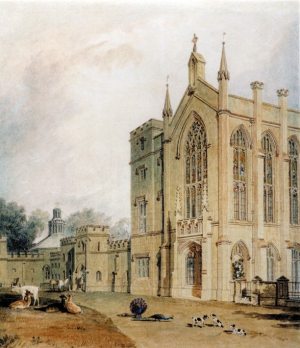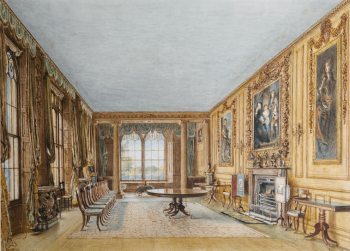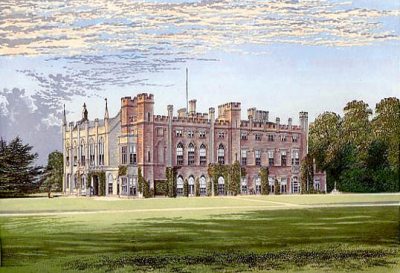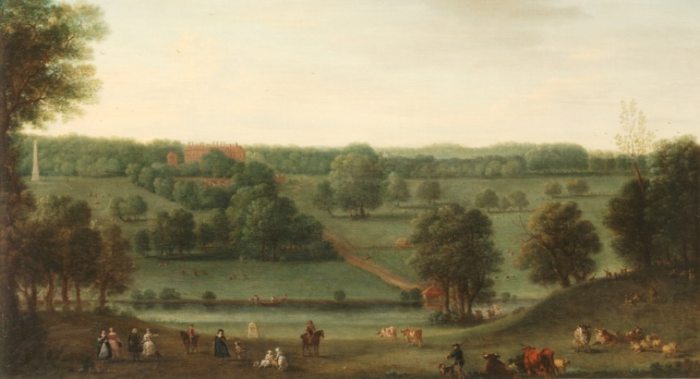The History of Cassiobury Park
In 2014 a book was published called “Cassiobury: The Ancient Seat of the Earls of Essex”. This was written by Paul Rabbitts and Sarah Kerenza Priestley and contains lots of information about the history of Cassiobury Park. The information below was written before 2014 and does not draw on the book, although it uses some of the same source material.
The Earls of Essex lived in Cassiobury House for more than 250 years. By the start of the 20th century the house was no longer used as a permanent residence and the estate began to be sold off.

Cassiobury House in 1707
In 1909, 184 acres of parkland were sold by the 8th Earl of Essex, mostly to Watford Borough Council for housing and the public park. More land for the park was purchased in 1930.
Construction of the residential Cassiobury Estate began. The land was made subject to restrictive covenants stipulating that only good quality detached or semi-detached houses would be allowed. Most activity was in the 1930s, though building still continues, mostly of “infill” housing on former back gardens. The park is bounded by Parkside Drive and Coningsby Drive on the north, and Cassiobury Park Avenue on the south.
On Thursday 8 June, 1922, at 2.30 p.m. at 20 Hanover Square, “By direction of the Right Honourable AdГЁle, Countess Dowager of Essex”, “Cassiobury Park estate including the historical family mansion, Little Cassiobury, and the West Herts Golf Links, embracing in all an Area of about 870 Acres” was auctioned by Humbert & Flint, in conjunction with Knight, Frank & Rutley.
Having remained unoccupied and unsold, the house itself was demolished in 1927. Only the stable block remains: this has been converted to Cassiobury Court, an old peoples’ home, which still exists in Richmond Drive. The grand staircase (said to be designed by Gibbons but since attributed to Edmund Pearce) was removed to the Metropolitan Museum of Art in New York. Other materials from the house were used to restore Monmouth House in Watford High Street. Posters advertised “To lovers of the antique, architects, builders, etc., 300 tons of old oak: 100 very fine old oak beams and 10,000 Tudor period bricks”.
In 1967, even the quaint, castellated entrance gates on the Rickmansworth Road were demolished to make way for a new traffic system.

South-West Front of Cassiobury House in 1806 (JMW Turner) – Watford Museum

Winter Dining Room, 1831 – Watford Museum

Cassiobury House in 1888
Parts of the content of this page taken from Wikipedia (released under GNU Free Documentation License).
http://en.wikipedia.org/wiki/Cassiobury_Park
Some images on this page are taken from Watford Museum’s Cassiobury Collection.







14 Responses
As someone interested in landscapes designed by Humphrey Repton, here is
a rare opportunity to buy a First Edition
Humphrey REPTON, ‘ Observations on the theory and practice of Landscape Gardening including some Remarks on Grecian and Gothic Architecture’,
published by Bensely, London, 1803.
11 cold aquatints, 9 with overslips, one folding.
Untrimmed edges. Inner joint weak, damage to 3 blank ffepp. & edge of Portrait only.
1/2 leather scuffed.
Estimate: ВЈ3,000 – 4,000
Lot 491 illustrations
http://www.catalogue-host.co.uk/mallams/oxford/2010-11-03/category_12_page_1 for photographs.
Saleroom: oxford@mallams.co.uk
Date: Wednesday 3 November 2010
Mallams
Bocardo House, St. Michael’s Street
Oxford OX1 2EB
Find this saleroom on a map at StreetMap.co.uk
Get driving directions to the saleroom at Multimap.com
Telephone: 01865 241358
Fax: 01865 725483
Viewing: Saturday 30th October, 9 am – 1 pm
Monday 1st November, 9 am – 5 pm
Tuesday 2nd November, 9 am – 5 pm
Morning of the sale
Number of lots:
679
Catalogue Sections:
Second Session (not to start prior to 2.30pm):
Antiquarian Books, Bindings, Natural History and First Edition Books
Session II: Botany, Natural History and Science (480 – 498)
Notes for all sales:
When requesting condition reports by e-mail please include your telephone number.
New research reveals the exciting news that the rebuilding of Cassiobury in the 1670s was designed by the world’s first woman architect, Elizabeth Lady Wilbraham (1632-1705), and that she engaged Hugh May to supervise construction and Edward Pierce/Pearce to execute the wood carving.
John Millar also confirmed, in an email to Richard Ahrens that Lady Elizabeth Wilbraham was the architect of Little Cassiobury (the Earl of Essex dower house) too.
Having been compulsorily purchased, in 1939, by Herts County Council part of the land was used to build Watford, and the house was used as education offices for most of the 20th century.
Little Cassiobury still exists in Hemstead road watford. It is grade II* listed.
Correction:-
Apologies for the gaffe.
My last should read
“…. to build Watford College, and the house was used as education offices for most of the 20th century.”
Do you know any of the history of the manor house said to have seen built by the 2nd earl of Essex in 1713. Any info would be much appreciated thanks.
John Evelyn’s diary describes Grinling Gibbons at work for the EArl of Essex at Cassiobury [April 18, 1680].
At the time Cassiobury was razed the Library carved panels by Gibbons were purchased for Charles Crane to be installed at his David Adler-designed mansion in Ipswich MA, The Crane Estate ‘Castle Hill’. is owned and managed by TTOR [The Trustees of Reservations] and is open to the public.
It is possible other elements of Cassiobury were purchased by Hearst for San Simeon in CA.
I am told my mother has a dining chair from Cassiobury House.
My aunt and uncle lived on Parkside Drive. My parents and I visited them during the 1950s and 60s. My 2 cousins Michael and Ann may still live around Watford; though I haven’t heard from them for many years. I remember it being a lovely area back then. My uncle was the manager of Watford FC many years ago and was a Lloyds Underwriter.
I have found out my grandad hotave godman was a gamekeeper at cassiobury estate I’m the late 19th century early 20th is there any way of finding out info?
Watford Museum has recently published a book Cassiobury- The Ancient Seat of the Earls of Essex- which has some splendid pictures of gamekeepers and domestic staff in it.
Before I was married my family home was in Langley Way. Would it be possible to show an aerial map of the Cassiobury Estate as it was in the 1960s with an overlying outline of Cassiobury House to see how it was situated. I remember friends who lived in “The Gardens” had wonderful loamy earth in their gardens. Perhaps their houses were built on the old rose gardens.
My maternal aunt and uncle used to live in Parkside Drive while my paternal grandfather was there in WW1 as a drill instructor with the Sherwood Foresters, leaving to help quell the Easter Rising. Does anyone have any info about that period of Cassiobury Park;s history? I have a picture of him with a platoon on some exterior steps.
Mary Forsyth’s new book “Watford A History ISBN 979 0 7509 6159 2 packs an extremely good overview of Watford from prehistory to 1945 into just 160 pages.
Cassiobury, and my personal interest Little Cassiobury, of course feature. This book is a very enjoyable read for anyone interested in Watford’s history.
Mary’s introduction lists similar works, and places them in the time they were written, and briefly what they focused on. The introduction ends with her expressing her hope to enable “…the general reader to trace the way in which the town has grown and changed over the centuries”.
Congratulations Mary. You did it.
Biggest mistake the council ever did was knocking the house down, Could have had Antiques roadshow, many a time, which in turn would have been great for the econmy of Watford, and then adding petrol to the fire, and doing the gates as well,very clever of council to knock diwn the Elms as well, then putting a listing on the town hall
Leave a Reply